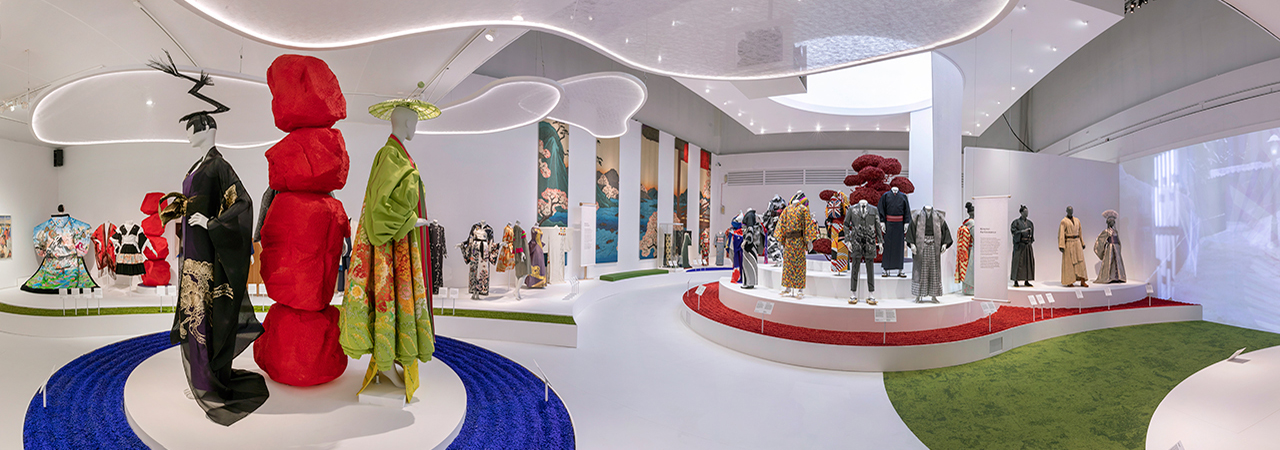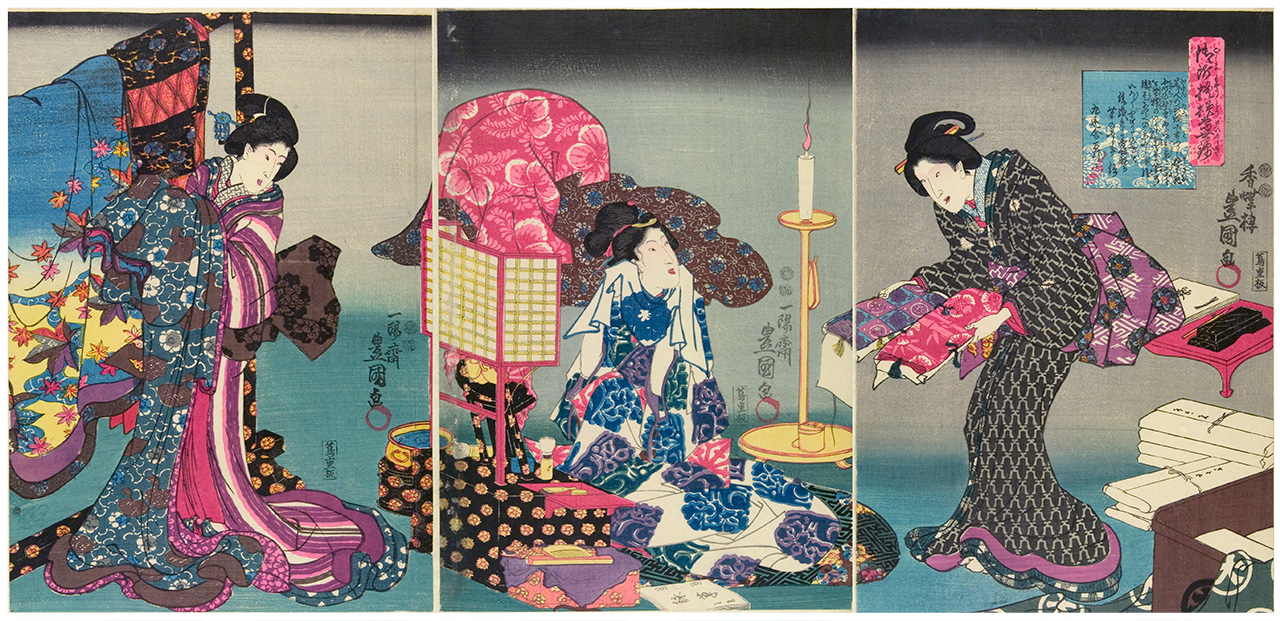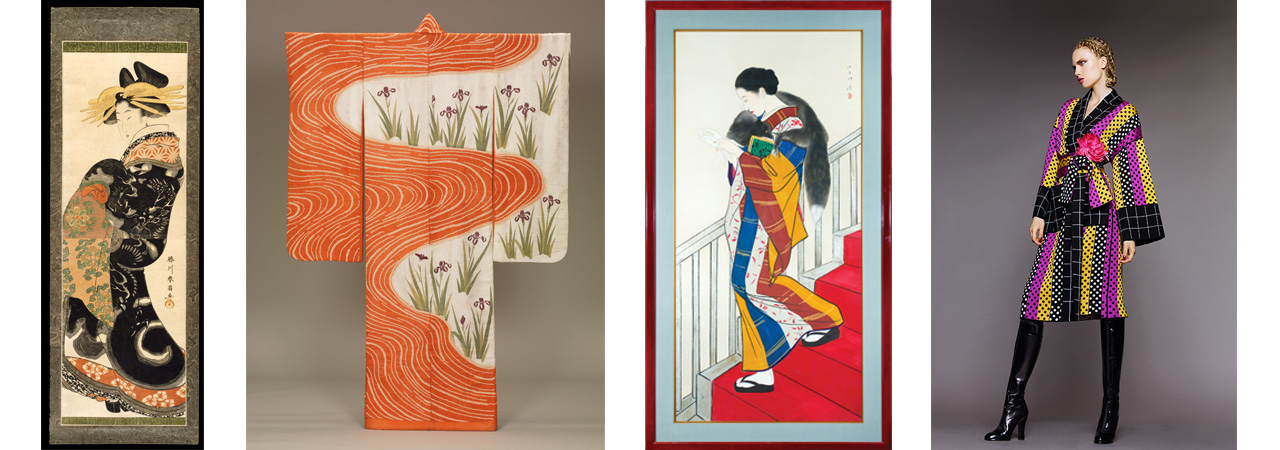Exhibition - Kimono: Kyoto to Catwalk
Victoria and Albert Museum (London)
(29 February - 21 June 2020)
Review by Duncan Bartlett

Europe’s first major exhibition of the kimono is a celebration of the garment’s unique place in the story of global fashion. The Victoria and Albert Museum in London is showing more than 350 creations in Kimono: Kyoto to Catwalk, which opened to the public on February 29th, 2020. Speaking at the opening of the exhibition, its curator Anna Jackson said: “We want our visitors to gain an appreciation of the significance and the sheer beauty of the kimono and we want to show that fashion is able to transcend geographic borders,” The exhibition includes many treasures, such as an 18th century summer kimono, which is yuzen-dyed and embroidered with golden-hued cherry blossoms. It is valued at around two million yen (about £14,000 or $18,000 USD) and it is too delicate to wear.
Despite being seen as uniquely Japanese, the kimono has had an influence on international clothing styles for nearly 400 years.The Director of the V&A, Dr Tristram Hunt, believes its allure stems from its simple structure which he believes invites people to create intricate designs upon its surface.“When we talk about kimonos, we often think of a beautiful and remote garment, a long way from ordinary people. This exhibition challenges that perception and it reveals that the kimono is highly dynamic. It's been the focus of a vibrant fashion culture which has existed in Japan since the 1660s,” Dr Hunt told reporters.
National treasures
The first part of the exhibition examines the history of the kimono, with many precious examples from Kyoto and Edo, the city which later became known as Tokyo. Some of the clothes come from the museum’s own archive – the V&A has been collecting Japanese art and design since it was founded in the early 1850s. There are also pieces which have been borrowed from all over the world, including loans from the Tokyo National Museum and the Kyoto Costume Institute.
People have been wearing kimonos in Japan for more than a thousand years. However, it was not until the 17th century that nearly everybody – regardless of their social status, wealth or gender – began to use them on an everyday basis.By that stage, there were a huge range of styles, patterns and materials. Each type carried much significance, according to curator Anna Jackson. Speaking in front of the some of the exhibits to a group of international journalists, she said: “The surface was really important and, of course, the choice of pattern and the colour. That's how you showed other people how wealthy you were, what your social status was and, most importantly of all, how fashionable and tasteful you were.”

Fashionable brocade patterns of the Imperial Palace, woodblock print, made by Utagawa Kunisada, 1847-1852, Japan. Museum no. Circ.636 to Circ. 638– 1962. © Victoria and Albert Museum, London
Overwhelming demand
Some of the most fascinating exhibits date from the period between 1639 and 1853, when Japan’s borders were largely closed to the rest of the world and it was known as sakoku "the closed country.” Despite this isolation, some entriped Dutch traders purchased kimonos in Japan and shipped them back to Europe, where they tried to sell them on at a vast profit. “At that time, Japanese manufacturers couldn’t keep up with demand, so kimonos were made in India to supply the European market,” according to Anna Jackson, who is responsible for the V&A’s Asian collection.
When Japan reopened its borders, western dress became popular. Yet even during the early 20th century, the majority of Japanese women continued to wear kimonos. The cut of the garment remained unchanged, but the designs were modernised. One charming painting in the V&A shows a kimono-clad woman as the epitome of modern sophistication, with a clutch bag under her arm and a fox fur draped over her shoulders. Although painted in 1935, she looks strikingly contemporary. One can easily imagine her sharing a selfie on social media.
Celebrity culture
The final section of the museum emphasises that kimonos have been much appreciated internationally since the end of the Second World War. There are examples of costumes worn by celebrities such as Freddy Mercury, Madonna and Bjork. “The kimono’s timelessness and ambiguity has always made it popular with performers,” Anna Jackson said during the opening. “It’s still having a big influence internationally. There are always ways it can be deconstructed and redesigned.” She particularly admires recent works by a new wave of designers from across the world – including many from Japan, such as Rei Kawakubo – who are part of a global a “kimono renaissance.”
Olympic link
The V&A’s Director, Tristram Hunt, enjoys drawing visitors’ attention to an intriguing link between a celebrated kimono and the logo of the Olympic Games, scheduled to be held in Tokyo in the summer of 2020.The logo includes a checkered pattern, shown in the traditional Japanese colour of indigo blue. It was designed to convey a feeling of elegance and sophistication.The pattern is known in Japanese as Ichimatsu the name of a kabuki actor who performed during the 1740s. Dr Hunt said: “The checkerboard on Ichimatsu’s kimono was influenced by fabrics from South Asia, which were imported into Japan by Dutch traders. I believe that this is eloquent proof that the story of fashion is so often a blurring of the unique and the universal, the familiar and the foreign.”

From left to right:
1) Parading courtesan, woodblock print, Katsukawa Shunsen, 1804-18, Edo (Tokyo), Japan. Museum no. E.12564-1886. © Victoria and Albert Museum, London
2) Outer-kimono for a young woman. Probably Kyoto, 1800-1830. Image Courtesy of the Joshibi Art Museum
3) 'Kaidan' ( staircase) by KobayakawaKiyoshi (1899-1948), hanging scroll, ink and colours on paper
4) Belted wrap coat, designed by Duro Olowu, Autumn/Winter 2015, England. © Duro Olowu

